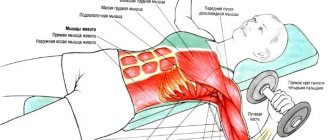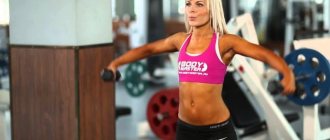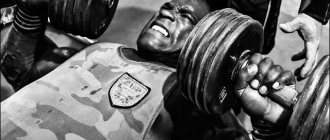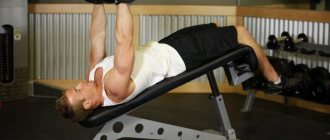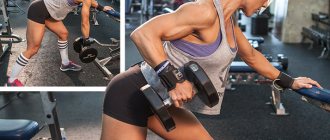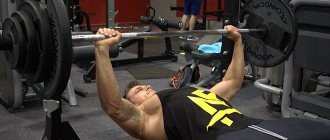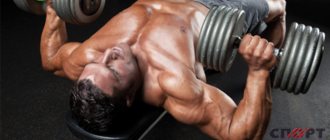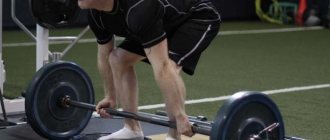A healthy lifestyle has become popular, many girls strive for an ideal figure by eating right and going to the gym. Most people do not pay enough attention to the chest muscles, and in vain. After all, the dumbbell bench press is just as important an exercise for girls as squats.
Don't miss the most popular article in the section: Body drying for girls. Training program, detailed nutrition menu for the month by day.
Dumbbell bench press for women: training goal
The dumbbell bench press is the basis of basic bodybuilding exercises. It is available in all gyms that have an incline bench and regular dumbbells. The main thing is to follow the correct execution technique so that the result appears.
Dumbbell bench press promotes ideal physical shape
When bench pressing with dumbbells, the following muscles are activated:
- pectoralis major muscle - it raises and reduces the elbows;
- the pectoralis minor muscle spreads the shoulder blades;
- the deltoid muscle provides movement of the upper arms;
- the triceps brachii helps straighten the elbow.
Not only working muscles play an important role, but also stabilizer muscles. These muscles do not directly assist in lifting dumbbells, but regulate the functioning of the core muscles.
Stabilizing muscles are:
- shoulder joint, rotator cuff muscles;
- lower part of the trapezius muscle;
- latissimus dorsi muscles.
They begin to practice exercises with the goal of working the pectoral muscles and increasing their performance. In everyday life, especially in girls, these muscles are little used and lose tone. To achieve aesthetic body proportions, it is important to master the dumbbell bench press technique.
Results appear after 1-2 months with regular training 2-3 times a week. If you don’t have time to visit the gym, some bench press exercises can be performed at home.
Inherent factors influencing the increase in the effect of training are:
- sleep pattern – it is important for muscle recovery after heavy physical exertion;
- proper nutrition - it is important not to starve, but to eat 5-6 times a day, but exclude fast carbohydrates and trans fats.
If these points are not followed, achieving results will be several times more difficult.
How to correctly perform 5 different options - photo
When performing this type of strength exercise, we primarily load the pectoral muscles, deltoids, as well as biceps and triceps.
Bench press or bodybar on a horizontal bench
This is a classic bench press. We work the middle part of the pectoral muscles. This is a great exercise for pumping up breasts for girls.
- Lie down on the bench.
- Take a bodybar or barbell with an overhand grip, hands slightly wider than shoulder-width apart.
- Remove the barbell from the rack and slowly lower it to your chest.
- After this, squeeze the weight upward.
How many times should I target? Perform three sets of eight repetitions.
Attention! Do not allow the barbell or bodybar to touch your chest.
Dumbbell bench press for girls on a horizontal bench
By performing this exercise, we work the pectoral muscles most effectively. Using dumbbells, you can better pump up your muscles, including small muscles that act as stabilizers. You can lift dumbbells from the floor yourself, or you can ask a partner to help.
Technique:
- Sit on a bench.
- Lower the dumbbells slightly above your chest, move your elbows to the sides: they should be located below your shoulders.
- The feet should be firmly on the floor with emphasis on the entire area of the foot.
- Press the dumbbells by straightening your arms, trying to bring the dumbbells together at the final top point.
Perform several sets of eight repetitions.
On an incline bench
When performing the exercise with your legs down, the upper part of the pectoral muscles is loaded. The dumbbell press, with your head lower than your legs, works the lower part of your chest muscles. When using small weights and high repetitions, it is excellent for removing chest fat.
Technique:
- Set the incline angle of the bench to thirty degrees.
- Take dumbbells from the floor, keeping your back straight and lifting by straightening your knees.
- Place the dumbbells on your thighs. Use force to lean back onto the bench while lifting your legs.
- Squeeze the dumbbells while straightening your arms. Maintain the natural curves of your spine and do not round your back.
Perform several sets of eight repetitions.
Close grip bench press for women
This movement maximally works the triceps in girls, and, therefore, allows you to tighten the muscles in the arms and effectively remove sagging skin.
- Lie down on a gymnastics bench. The hands are already closer than shoulder width.
- Remove the weight. Hold it up and place it in the middle of your chest.
- Slowly lower the bodybar or barbell, not reaching the chest.
- During the exercise, the elbows are constantly near the body.
- Push the barbell up.
We perform several sets of eight repetitions.
On fitball
The dumbbell bench press on a fitball allows you to work not only large, but also small muscles that are involved in maintaining balance.
Technique:
- Taking the dumbbells in your hands, we lie down on the fitball, placing our lower back firmly on the ball.
- Maintain balance with a straight back, pressing your feet firmly to the floor.
- We lift dumbbells, with our arms turned palms forward - this will allow us to focus on working the pectoral muscles without putting the load on the deltoid muscles.
- We lower and raise the dumbbells measuredly, slowly, bending and straightening our arms at the elbows.
We perform several sets of ten repetitions.
Peculiarity! Remember that it is contraindicated to use heavy weights when exercising on the ball. It is better to do the first workout without using weights.
How to use the bench angle correctly
In most cases, bench presses are performed in a horizontal position. Incline benches are often left empty, as the effect of performing the exercise on them is underestimated.
The dumbbell bench press appears to be something useless for girls, especially at an incline angle. But the incline of the bench allows you to more effectively work the pectoral muscles and use the rest.
There are several options for inclining the dumbbell bench press:
- Negative. In another way it is also called “reverse or head down”. This type of inclination is used to work the expressive lower part of the pectoral muscles. It is especially useful for girls, as it allows them to tighten their breasts and décolleté. Also, when performing the exercise with a negative incline, performance in the regular bench press improves. The correct technique allows you to remove significant stress from the shoulder joint.
- Positive. This angle of inclination engages the upper pectoralis major muscles, improving their balance and shape. Moreover, the positive incline bench press targets the pectoralis minor, triceps, and anterior deltoids, allowing you to strengthen multiple muscle groups at once.
It is important to alternate the dumbbell press on an incline bench with the classic bench press in a horizontal position to deeply work out the muscle group. If you perform the bench press only on a horizontal bench, then the indicators will increase more slowly, and the shape of the pectoral muscle will be a little flat. Also, a lot depends on the level of inclination, since both positive and negative angles can be adjusted.
Traffic safety
There is an opinion that the back should be pressed against the bench in the lumbar region. In fact, removing the natural lordosis of the lower back will do nothing in terms of safety. But a relaxed upper back is the cause of an athlete’s unstable position and injuries. In order for the athlete to perform the movement safely, the back should be tense and the shoulder blades not spread along the plane of the back. The movement should not be done on a relaxed back, but lumbar lordosis is an acceptable thing.
The second point is that the sneakers should not slide if the exercise is done with emphasis on the floor, and the legs should not move along the surface. Leg support should be trained in all presses, as it is the key to the correct starting position of the athlete on the bench.
The assistance of the insurer is mandatory. In fitness gyms, bench press racks are made in such a way that only a person of a certain height can safely remove the barbell themselves. People below 170 cm and above 186 cm usually have problems with this. Yes, and lifting a barbell from the racks is a skill; if it is not trained, after independently picking up the apparatus, the athlete remains lying on a relaxed back, with his shoulders rounded forward, which is unacceptable due to safety regulations.
The warm-up for the incline bench press is usually a classic press. Or the athlete performs an incline press with an upward incline to target the upper chest first. The only point is that the first approach should not be performed with a working weight. Typically, any approach is preceded by rotation of the shoulder joint, that is, exercises to rotate the shoulder outward and inward, and warming up the elbows and wrists. Some athletes are accustomed to doing one set of any movement on the back, for example, pull-ups, to feel the collection of the shoulder blades.
Important: high blood pressure in an athlete is a contraindication for performing this type of bench press. Avoid doing incline bench presses with the bench sloping downwards and if the athlete experiences dizziness when standing up. The exercise is not recommended if you are taking medications to nourish the blood vessels of the brain. Also contraindicated is injury to the muscles of the chest, triceps and shoulder, as well as shoulder, elbow joints and wrists.
Incline press at 30 degrees
The 30° incline press works the chest, triceps, and anterior deltoids.
Execution principle:
- In the initial position, you need to lie on a bench, pressing your lower back and buttocks tightly against it. The feet are firmly on the floor.
- As you inhale, lower the projectile until your forearms are parallel to the floor.
- As you exhale, the projectile rises to its original position.
It is important to follow several rules: do not allow the dumbbells to collide at the highest point, do not arch your lower back. The number of repetitions for girls is 10-15 if the weight of the apparatus is from 4 to 6 kg.
Press at a 40 degree angle
The dumbbell bench press for girls at an angle of 40° differs from the previous exercise in that the shoulder joints work more. If it is necessary to achieve development of the muscles of the shoulders and chest, you need to increase the inclination of the bench.
The principle of execution is the same as a bench press at an angle of 30°. It is not recommended to set the bench angle to more than 40°, since in this case only the shoulders will be involved.
Useful tips
The dumbbell bench press with a negative angle is one of the effective exercises for developing the lower part of the pectoral muscles. But, as practice shows, not all beginners need additional work on the lower chest. The classic bench press is enough.
However, there is a category of guys and girls who would like to correct the lower part of their chest. One way or another, the exercise is worthy of attention and even for the sake of variety it is worth including in the training plan.
Research shows that the dumbbell reverse press is one of the most effective exercises for working the lower pectorals, unlike the barbell. This is evidenced by experiments conducted in the USA using special equipment. It detects the electrical activity of muscles during specific exercises.
Here are some useful tips to help you perform the exercise:
- Choose the right weight. It should be comfortable to work with, without compromising the technique. As a rule, the ideal weight is 15-20% less than the classic horizontal bench press.
- When working with heavy weight, ask for backup. Have your partner squat down and help you squeeze by pushing your hands under your elbows.
- Try using supination and pronation. Supination involves turning the palms outward at the top point. Pronation - turning the palms inward towards each other at the lowest point.
- To make it easier to get up, take 2-3 breaths and then get up. This will normalize the pressure.
- Perform the movement through its full range. Only with full amplitude can the desired result be achieved.
- After each approach, it is definitely recommended to walk rather than stand still. This will avoid a huge rush of blood to the head due to circulation during movement.
Close grip press
When performing a bench press with a close grip, the triceps and triceps brachii muscles are mainly used.
Execution method:
- In the initial position, you need to lie on your back, your lower back pressed against the bench. The hands are positioned on the bar narrower than shoulder width.
- As you inhale, the barbell lowers to your chest; your elbows should not be moved far from your body.
- As you exhale, the projectile returns to its original position.
To achieve the best result it is important:
- do not straighten your elbows all the way at the highest point;
- lowering the barbell to the chest should be twice as slow as lifting it to the starting position;
- elbows move along the body.
Correct technique
The correct technique for pressing the barbell head down is 70% of all success in achieving the result you want:
- First, you need to position yourself correctly on the bench so that you are comfortable. Then secure your legs in one position.
- The bar should first be taken with a medium grip (if you are new to this), this is necessary to create the correct angle between the forearm and shoulder.
- The barbell must be grasped firmly and removed slowly; this technique will prevent muscle strains and injuries. Place your arms perpendicular to the floor.
- Take a deep breath and begin to slowly lower the barbell to your chest, and then also slowly lift it up. If you feel that performing this exercise is difficult for you, seek help from a friend who can always back you up and, if necessary, take the entire weight of the barbell upon yourself.
- To effectively perform the barbell press lying head down, we recommend doing 2-3 sets 7-10 times.
Bench technique for burning fat
The dumbbell bench press for girls is a great way to reduce the percentage of body fat. While maintaining the execution methodology, several requirements are added.
The main ones:
- The nature of the training. To reduce adipose tissue, you can use pumping style or circuit training. Pumping involves pressing light weight dumbbells for the maximum number of repetitions (from 12 to 25). During circuit training, the dumbbell press is performed in several variations, but the exercises follow one after another, without interruption. At the end of the cycle, rest is no more than 3 minutes.
- Proper nutrition. Without maintaining the ratio of proteins, fats and carbohydrates 30/10/60, subcutaneous fat will not decrease.
What is important about the bench press technique for burning fat is that there is a large expenditure of energy, which the body draws from fat reserves.
Press technique to increase muscle mass
The barbell or dumbbell press is often used by experienced athletes to gain muscle mass. In order for the exercise to achieve its goal, it is necessary to follow the generally established rules.
The basic rules include:
- the number of repetitions is reduced to a minimum, while the weight of the projectile is set to the maximum possible;
- increasing the number of approaches from 7 to 10;
- greater range of motion, the arms must cover a greater distance, then the muscles will be under maximum tension;
- the speed of movement should be low.
When all the rules are followed, the involved muscle fibers rupture and they begin to grow.
Don’t miss the most popular article in the section: Glutamic acid - what it is, why and how it is used in sports and bodybuilding.
Techniques for burning fat and increasing pectoral muscle mass
Many people set a goal to lose weight without losing muscle mass and the attractiveness of their body.
This can be done by following simple tips:
- The bench press technique should combine both high-repetition exercises and work with heavy weights. This load allows you to increase the mass of the pectoral muscles, while reducing the fat layer, since a large number of repetitions are performed using carbohydrates, and a small number - due to proteins.
- It is necessary to add aerobic exercises to strength exercises - walking, running, jumping rope.
- Basic strength exercises for various muscle groups cannot be ruled out; they help burn fat throughout the body.
An increase in muscle mass does not always entail a significant weight gain. With the right technique, you can combine muscle gain and weight loss.
Dumbbell fly
How to do it:
- in the initial position, you need to lie on a bench and press your lower back, arms with the apparatus bent at the elbows;
- the dumbbells are moved apart, while the angle at the elbow joint decreases as you inhale;
- As you exhale, the arms with the projectile return to their original position.
It is important when performing the exercise not to bend your elbows too much when spreading to the sides. It is also necessary to monitor the position of the lower back.
Dumbbell bench press with a narrow parallel grip
When pressing dumbbells with a narrow parallel grip, the muscles of the chest, back and triceps work.
Exercise method:
- in the starting position, the athlete lies down on the bench and presses his lower back tightly, turns his hands with the apparatus, palms facing each other, shoulder-width apart;
- while inhaling, the arms are lowered until an angle of 90° is formed with the forearm;
- As you exhale, the dumbbells are pushed out by the pectoral muscles, and the arms return to their original position.
Dumbbell bench press with supination and pronation
The dumbbell bench press with supination and pronation allows you to get all the benefits of the dumbbell exercise.
Order of exercises:
- When performing a press with supination, the starting position is maintained as with a regular bench press on a horizontal bench. When raising your arms while inhaling, you need to turn your palms towards each other. Rotation is accomplished not by the wrist, but by the elbow joint.
- When pressing dumbbells with pronation, everything is done the other way around: in the starting position, the palms face each other, and at the top point they face forward.
To achieve the best results, you need to bring your shoulder blades together and straighten your chest.
Technique for performing dumbbell bench press
Most novice athletes who come to the gym for the first time make a huge number of mistakes. If you are a complete beginner in the world of weightlifting, be sure to use the services of an experienced mentor, because the technique of performing a dumbbell bench press is not as simple as it seems from the outside. The trainer will help you create a training program and also advise you on nutrition. Already at the first training session, you can learn about the technical difficulties of the dumbbell bench press and the rules for performing the exercise.
Beginners are recommended to go to the gym with a friend for the first time. The dumbbell overhead press requires a special technique from the athlete. But if you do not have the opportunity to exercise with a partner, then remember a special algorithm for performing movements.
Before starting the exercise, you must select dumbbells of the appropriate weight. Work with a light load at first. At first, the athlete needs to work on improving technique. After you can perform all the elements correctly, take heavier sports equipment.
The technique for performing a dumbbell bench press is as follows:
- Lift the dumbbells off the floor onto your thighs. With a jerking movement, you should lie down on the bench and take your starting position.
- Make yourself comfortable. Bend your back slightly at the lower back. The head and shoulders should be pressed tightly to the surface. Direct your gaze upward. It is also important that your feet are firmly planted on the floor with full feet. Space them a little further apart than the width of your shoulders.
- Hold the projectile tightly in your hands. Elbows should be straight or slightly bent.
© Mircea.Netea — stock.adobe.com
- Begin to lower the dumbbells synchronously as you inhale, and as you exhale, press them up.
© Mircea.Netea — stock.adobe.com
- As you move, firmly fix the position of your wrists.
- The dumbbell bench press on a horizontal bench should be performed at the same amplitude as normal work with a barbell.
- After you have finished performing the exercise, carefully place the dumbbells on the floor. If you work out in the gym with a friend, he can take the sports equipment from your hands.
Alternating Dumbbell Bench Press
This type of press can be performed on a straight bench or on an incline bench. The exercise allows you to maximally work out the left and right sides of the chest separately.
How to do the exercise:
- for the starting position, you need to lie on a bench and move your arms to the sides at an angle of 90°, elbows facing the floor;
- while inhaling, the right hand rises up;
- as you exhale, the right hand lowers to its original position;
- on the second inhalation, the same is done with the left hand;
- As you exhale, both arms return to their original position.
Dumbbell bench press for girls on a horizontal bench
The non-incline dumbbell bench press is a great way to build the strength and quality of your chest muscles.
How to do the exercise:
- in the starting position, you need to lie on a bench, tightly fixing your lower back, arms with the apparatus spread to the sides at a right angle, elbows directed towards the floor;
- while inhaling, a pushing movement is made and the dumbbells are brought together, but do not collide;
- when exhaling, you must return to the original position.
Anatomy
The overhead press targets the strongest core of the pectoral muscles, but isolates it, so the weight should be selected with this factor in mind. In addition, since the athlete lies upside down, the exercise must be performed in the range of 12-15 repetitions, that is, with a weight at which energy is supplied through glycolysis and the formation of lactic acid. It is precisely because of the latter that there is a need to monitor breathing so carefully, since proper breathing facilitates the work of the liver. In addition, proper breathing will help reduce intracranial pressure.
From an anatomical point of view, the head down press is not the best exercise, so it should not be performed often, but only in specialized training programs. And beginners certainly shouldn’t perform this exercise in their first training programs. It should also be noted that in this exercise the shoulder joints are not in a very comfortable position, so it is better to move your elbows not to the sides, but to move them along the body as powerlifters do. To summarize, we can say that the exercise helps correct imbalances in breast development, but it should only be used by experienced athletes.
Other exercises
Dumbbell bench press with a reverse, negative downward inclination
The negative incline dumbbell bench press is also called the reverse incline or downward incline press. This type of press works the lower chest and triceps.
Execution method:
- for the starting position, the bench is lowered down, you need to lie down so that your head is lower than your torso, your legs are placed under the fixing bolsters, your hands hold dumbbells shoulder-width apart;
- as you inhale, lower the dumbbells to the lower chest, do not move your elbows far from your body;
- as you exhale, return the projectile to shoulder width.
The dumbbell bench press with a negative incline is very useful for girls, as it helps tighten the breasts, give them elasticity and create aesthetic shapes.
Incline bench training (muscle atlas)
Bent over training involves different positions of the lower extremities relative to the head, due to which the load is redistributed. So, performing a barbell press with your head down, i.e. when the head is lower than the legs, the lower part of the chest muscles is loaded. The large muscle, as is known, consists of a lower and upper part. The first is called the “sternal head”, the second is called the “clavicular head”. They both perform arm adduction, i.e. pull the limbs towards the midline.
The head-down barbell press directs the load (almost all) to the sternal head, and training is most effective at an inclination of 20-45 degrees.
The following muscles also participate in the head-down barbell press: the anterior deltoids and triceps, which experience greater load when replacing the grip with a narrow one.
The anatomical atlas looks like this:
Bodybuilders use it if they need to thicken the lower edge of the pecs and “cut” them, making them more expressive and separating them from the main body.
Dumbbell bench press with positive incline
The positive incline dumbbell press involves lifting your torso up at a certain angle. The standard angle of an incline bench is 30-40°. It makes no sense to set a larger angle, since the load will transfer completely from the chest to the shoulders.
The dumbbell bench press with a positive incline is suitable for those who have experience with the classic press. A positive incline allows you to work the chest muscles, along with the triceps and deltoids.
How to do it:
- in the starting position, you need to lie on a bench with an incline, your feet pressed to the floor, your hands holding dumbbells shoulder-width apart;
- as you inhale, lower the dumbbells below the chest line, do not move your elbows far from the body;
- As you exhale, lower your arms again to shoulder width.
Types of exercise
To better work different parts of the pectoral muscles, experienced bodybuilders use different variations of the same exercise. You can perform the dumbbell bench press in different positions and in different ways:
Incline Dumbbell Press
This exercise is ideal for pumping the upper chest. Before approaching, you should choose a bench whose incline can be adjusted. The most common variation of the set is the dumbbell bench press at an angle of 30 degrees (45 degrees).
© Makatserchyk — stock.adobe.com
This type of exercise is better suited for athletes who already have some experience in the exercise. The athlete's deltoids and triceps also receive additional load. The incline dumbbell press should be performed using the same technical principles as a regular exercise.
The dumbbell bench press on an incline bench is also recommended for those athletes whose upper chest requires training. If you feel pain in your shoulders while performing the exercise, you need to slightly rotate the dumbbells. This will reduce the stress on your shoulders.
© Dooder — stock.adobe.com
Negative incline dumbbell bench press
The negative incline dumbbell bench press is ideal for athletes who want to pump up the lower chest, as well as make the target muscle group more prominent. During the exercise, the athlete also uses the triceps and deltoids. In order to perform a set, you need to choose the right bench. The negative tilt angle should be 30-45 degrees.
There are several nuances to the dumbbell bench press with a negative incline:
- Suitable only for athletes who have been visiting the gym for a long time.
- Athletes often experience dizziness. Do not stay upside down for long periods of time. Monitor your own condition.
- It is very important to breathe correctly, do it smoothly and evenly.
- The exercise can be performed on a special bench for the press.
- An alternative to dumbbells can be a barbell or chains.
- After finishing the set, rise carefully. You may need some insurance.
© Dooder — stock.adobe.com
Alternate Dumbbell Bench Press
The exercise can be performed while on a bench with any incline. In this way, you can better work each hand in turn. Attention will be focused on the work of the left and right thoracic regions. The essence of the exercise is to raise your arms up not simultaneously, but one at a time.
Advice from professionals: how to increase the effectiveness of your training
Many experienced athletes note that the effectiveness of training directly depends on how correctly the basic generally established rules of training are followed.
The rules are as follows:
- Execution technique. If the exercise is performed with technical errors, the result will be zero, since the muscles will not be correctly involved in the work. This is not only useless, but also unsafe. If the technique is incorrect, injuries and joint damage may occur. In order to supply the correct technique, it is advisable to use the services of a professional trainer at the initial stage.
- Regularity of training. It is important to follow a gym routine, since long breaks reduce the results to a minimum and you have to start all over again.
- Recovery. Excessive constant stress is just as harmful to the body as lack of activity. Training should end with recovery, that is, sleep for at least 8 hours. It is important to take breaks of no more than 3 days between workouts. It is recommended to take a two-week vacation every six months. For recovery, it is also important to eat right, include more protein and fiber in your diet, which promote muscle growth.
- Keeping an exercise diary. This technique promotes self-control and tracking progress in training. In the diary you can note your training calendar, strength indicators, duration of the session and weight.
The dumbbell bench press is an excellent way for girls to develop strength and endurance and increase the percentage of muscles in the body. The bench press also helps you lose weight or gain muscle mass, depending on the chosen technique.
Middle section
EXERCISES
BARREL PRESS ON A HORIZONTAL BENCH
The most rated exercise for beginners. But this, alas, absolutely does not guarantee that they are doing it correctly. The classic bench press, one of the three basic exercises, has a lot of subtle nuances that need to be understood from the first training: then it will be difficult to relearn. Lie down on a horizontal bench so that the barbell mounted on racks is at your eye level. Grasp the bar with a FULL grip: wrap your thumb around it for safety. An incomplete grip - “without a thumb” - is too risky: God forbid, you will drop the barbell from your hands. It’s unpleasant when a hundredweight falls on your chest. I once had a gold pendant bent for this reason. The grip width should be such that when the bar touches the chest, the arms bend at the elbow joints at a clear right angle. Arch your lower back, press your shoulder blades to the bench, stick out your chest, straighten and lock your shoulders. Make sure that the shoulder joints do not rise up during movement, otherwise a fair portion of the load will go to the anterior deltoid muscles. And don't tuck your elbows in so you don't put too much stress on your triceps. Lower them straight down. Place your feet firmly on the floor, do not lift or move them during the approach. And please, do not place them on the edge of the bench: in this case, the body will lose stability, and the efficiency of the exercise will noticeably drop. Remove the barbell from the racks with a smooth yet powerful movement. Slowly lower the bar onto your chest under your nipples and press the weight up a little faster. Don't lift your pelvis off the bench! Don't go around the perimeter with them! This will give nothing but potential problems with the spine. Do the exercise honestly and cleanly, without wobbling or waving. At the top point, do not overextend your arms at the elbow joints, do not place the barbell on the joint! Keep your elbows slightly bent and begin lowering the weight again. Take care of your joints. They still have to work and work. Perform deliberately difficult approaches ONLY WITH A PARTNER! The exercise works: the pectoralis major muscles, especially their middle and outer parts, as well as the pectoralis minor and serratus. The synergists are the anterior deltoids and triceps. The antagonists are the back muscles. Stabilizers, as in all three basic exercises, can include all other muscles of the body. The biceps work especially well.
DUMBBELL PRESS ON A HORIZONTAL BENCH
The technique is the same, only instead of a barbell in the hands there are dumbbells, which together should weigh 20-30 percent lower than the working weight of the barbell: it is much more difficult to control dumbbells. But they have more amplitude capabilities and give the muscles a complete shape.
DUMBBELL FLIES LYING ON A HORIZONTAL BENCH
But here it’s different. Firstly, the dumbbells will have to be made even lighter. Secondly, now you will limit the work to only the shoulder joint: the elbow will be fixed. Starting position: lying on a horizontal bench, raise your arms with dumbbells up and bend your elbows 10 degrees (no need to measure: estimate by eye). Elbows point straight to the sides. Now VERY CAREFULLY lower your arms to the sides until you feel that your pecs are well stretched. Slow down and return to the starting position under control. The movement should be as if you were hugging a thick tree trunk. At the top point, do not release tension and immediately change the direction of movement, continue the approach. You can't give your muscles rest. You will relax at home on the couch. And now we need to work! The fly (colloquially known as the fly) places a distinct emphasis on the outer middle section of the pectoralis major muscle and thereby sharpens its shape.
RELATED HANDS ON THE BOTTOM BLOCK LYING ON A HORIZONTAL BENCH
An interesting modification of the previous exercise: instead of dumbbells in your hands, you have the handles of the lower block. Accordingly, the bench must be placed between the two crossover rods. The technique is the same. But thanks to the use of a block, the internal parts of the pectoralis major muscle are also involved in this case.
ARM CRACK ON THE EXERCISER (“NAUTILUS”)
This simulator has another name: “Butterfly” - that is, a butterfly. He imitates the flight of this graceful insect: bringing and spreading his arms, as if flapping his wings. Unlike the fly, the Butterfly more actively loads the inside of the entire pectoralis major muscle and acts as an alternative to the low pulldown we just looked at. In nature, there are two modifications of the “butterfly”: one offers emphasis on the elbows, the second on the hands. In the first case, the lower parts of the chest are more actively involved, in the second - the upper parts of the chest.
Sit on the “Butterfly”, press your shoulder blades tightly to the support, arch your lower back, straighten your chest and turn your shoulders. Grasp the holders of the machine. Bringing your hands together, pause for one second at the point of maximum tension and increase it with volitional effort. Then smoothly return to the starting position, but do not allow muscle relaxation! Don't look for a reason to rest! Start the next repetition immediately. Let's agree at the very first training session: we will work efficiently. Or we won't do anything.
